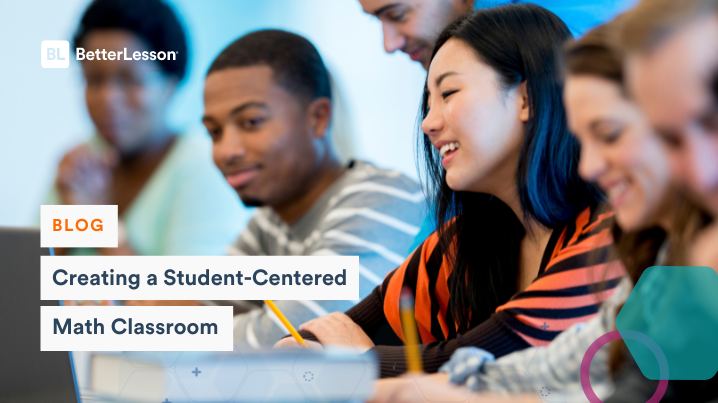Math teachers face unique challenges. For one, research indicates that the majority of math teachers view “math anxiety” as a serious learning hurdle for their students. On top of that, recent survey data tells us that the general public agrees that while math is an important subject, as it is currently taught, it is not relevant to students’ lives or real-world experiences. This is anecdotally affirmed in most math classrooms when students ask, “Why do we need to learn this?!”
While these challenges cause frustration for many students, they also cause frustrations for teachers who want to leverage their passion for math and student learning in engaging and productive ways. The often unanswered question is: How can we approach math education differently?
Student-Centered Math: An Engaging and Relevant Approach
Student-Centered Math is a transformative approach that offers educators a new and engaging way to approach their instruction. Rather than approaching math as a stand-alone subject, Student-Centered math supports students in connecting math to real-world ideas and situations, communicating their mathematical thinking, and preserving in problem-solving.
While there is not a singular approach to Student-Centered Math, there are common characteristics of the pedagogy. According to a study published by the Nellie Mae Education Foundation, Student-Centered Math teachers generally engage in the following practices:
- “Use mathematical reasoning to understand the ‘why’ as well as the ‘how.’
- Communicate their mathematical thinking and critique the reasoning of others.
- Make connections between and among mathematical concepts and real-world concepts.
- Engage and persevere in solving mathematical problems that extend beyond the rote application of procedures.”
A key feature of these practices is student discourse. Traditionally, math is viewed as more of a solitary and silent subject: students learn how to solve particular math equations and then work independently to solve practice equations. With a student-centered approach, student discourse is at the forefront. This means that students are working collaboratively with peers to discuss mathematical concepts, identify connections to real-world topics, and explore different approaches to solving problems. Allowing structured time and space for students to talk through their mathematical thinking has tremendous academic benefits. In fact, research illustrates that student discourse in math instruction allows students to develop deeper understanding of mathematical concepts.
Creating a Student-Centered Math Classroom
Developing a student-centered approach to math might sound appealing, but how can teachers take actionable steps to shift their teaching? Below are a few instructional shifts and practices that math teachers can use to develop a more student-centered approach.
Understand Students’ Perceptions of Math
As already discussed, many students struggle with math anxiety. To alleviate this, it can be a helpful practice for math teachers to learn about their students’ experiences and perceptions of math. This not only provides critical insight for the teacher to understand which students might need extra support and encouragement, but it de-stigmatizes math anxiety. If students know that they aren’t alone in their fears and anxiety around math, they are more likely to ask for help.
Here are some instructional strategies developed by BetterLesson Master Teachers to help explore students’ perceptions of math:
- Math Autobiographies: Math autobiographies are a meaningful tool for humanizing math class and helping you center your math instruction on the individual needs and interests of your students.
- Creating Mathematical Counter Narratives: In this strategy, your students are given the opportunity to challenge this dominant cultural narrative and are given an opportunity to write their own counter narrative that embraces their personal strengths and potential as math learners.
Ground New Concepts in Real-World Contexts
A core component of student-centered math is ensuring that students understand how concepts have real-world application. At the introduction of each new math topic, begin by grounding the topic in practical problems or situations. Starting with this provides students with a clear context for the math concept.
As students deepen their learning of math concepts, they may develop their own ideas about how concepts translate to real-world application. Create space – during class discussions, debriefs, exit tickets, etc. – for students to share those perspectives! As students develop their own ideas about real-world connections, teachers can start to create more relevant lessons and projects that relate to student interests and experiences.
Here are some instructional strategies developed by BetterLesson Master Teachers to help connect math instruction to real-world contexts:
- Building Personal Connections to a “Real-World” Math Problem: This strategy will support you to support students to build background knowledge to find tasks meaningful and to explore options for tweaking or supplementing curriculum materials to incorporate contexts that are more compelling or relevant to their specific students.
- Planning for Problem-Based Math Curriculum Units: This strategy will provide suggestions using Open Up Resources Math, but the approach can be applied to other problem-based math curriculums.
- Everyday Inquiry in Mathematics: This strategy offers three different opportunities for supporting teachers in facilitating student-led instruction from a range of 5 to 30 minutes each class meeting time.
- Strategically Planning a Problem-Based Lesson with OUR Math K-8: This strategy supports teachers to internalize how the structure of a problem-based lesson builds understanding and moves students toward learning expectations.
Frequently Incorporate Structured Math Discourse and Collaboration
Students need time and space to reflect on and discuss new math concepts. Creating structured opportunities for student discussion reinforces and deepens their learning. A key to impactful discourse is regularity. Rather than an occasional add-on or opening activity, student discourse needs to be woven into math instruction for it to have a meaningful impact on student learning.
Here are some instructional strategies developed by BetterLesson Master Teachers to help facilitate meaning math discourse:
- Fostering Mathematical Discourse in Your School: This strategy helps create a culture that supports discourse in math classrooms.
- Explain Mathematical Thinking: This strategy supports students to be able to explain how, when, and why they used specific strategies or steps to solve a math problem.
- 2, 4, 6, 8 Collaborative Problem-Solving Structure: 2,4,6,8 Collaborative Problem-Solving supports students to engage in independent and collaborative thinking to effectively problem solve.
- Discussion Supports: To support planning and effective discussions, this strategy includes multi-modal approaches for helping students comprehend complex language and ideas via discussion, and can be combined and used together with any of the other Mathematical Language Routines or discussion strategies.
Normalize Struggle
No matter how many support and differentiation strategies a math teacher implements, students will still have moments of struggle. Because math is already a more anxiety-provoking subject, teachers can proactively address this by normalizing struggle. By taking away labels like being “good at math” or “bad at math,” and instead modeling and explicitly teaching struggle as a natural part of the learning process, students can build resilience as they learn new and more complicated math topics.
Here are some instructional strategies developed by BetterLesson Master teachers to help normalize struggle in math classrooms:
- Teaching Perseverance in Math: Teaching perseverance helps students understand how productive struggle helps them grow in their ability to solve Math problems.
- Validating Language to Build Trust: Regardless of how the teacher enters into the conversation, this strategy is essential in building a positive relationship between the student and teacher.
Supporting Student-Centered Math Classrooms
Moving from more traditional math instruction to a more student-centered classroom requires a lot of support. For many teachers, these instructional strategies are a real paradigm shift, a significant change from both how they learned math and how they’ve been taught to teach math. Providing actionable professional support ensures that teachers can implement these shifts with fidelity and confidence.
However, oftentimes schools don’t necessarily have the internal capacity to provide such support. In those instances, outsourcing professional support can be a helpful approach. Whatever your path toward student-centered math classrooms looks like, the outcomes are transformative: empowered and confident students, meaningful and authentic learning, and genuine engagement.
Schedule a call with us today to learn more about how we can work together to create Student-Centered Math classrooms in your school!
Get in Touch







